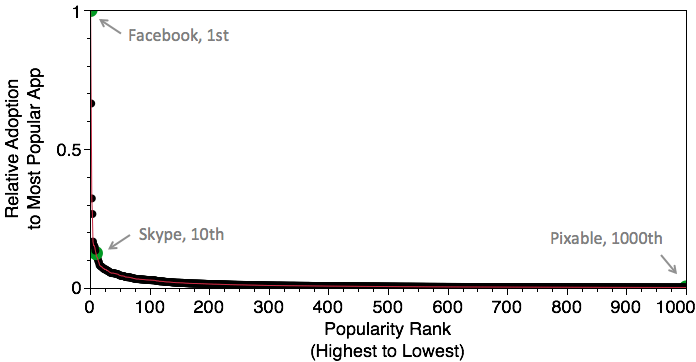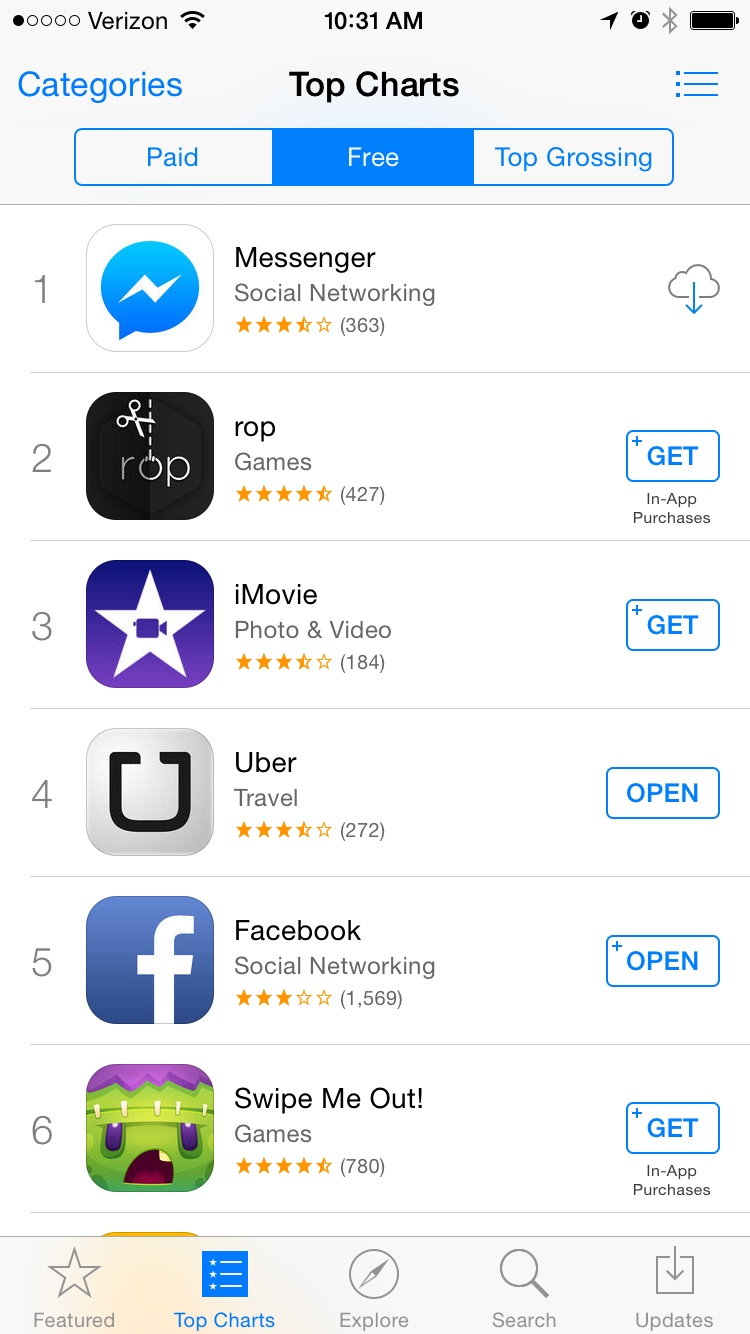“It’s just too saturated. The barriers to adoption and therefore monetization are too high. It’s easier on the web.”
Said my friend as he described why his company stopped building native apps. It’s easier to build a business on the web. How could that be? The browser-based web app ecosystem has existed for more than 20 years while the app ecosystem has existed for only 6. One thing is for sure, it’s not because there are fewer websites than apps.
My mind then wandered through this ‘saturation’ concept. If anyone remembers high school chemistry, saturation is the state where a solution is no longer capable of absorbing a new compound. For example, you can continue to stir salt into water until the solution becomes saturated, at which point any new salt added will immediately sink to the bottom no matter how much stirring you do. At some point, the water has just had enough salt.
Why is it that the mobile app medium has become saturated with apps while the mobile web is still capable of absorbing more websites? Is there anything we can do at this point?
How Bad is the Mobile App Ecosystem?
At Branch, we’ve created the deep linking standard for app developers that helps companies drive growth and re-engagement to their business. Half a billion people per day access apps across the thousands of apps on the Branch network. We can see the problem first hand.
I took a look at the breakdown of relative traffic (measured in relative total rankings) to the top 1000 non-games in the iOS App Store and the results are frightening. Just look at this graph:

The punishing app adoption power law
As you can see, as you approach even the 10th most popular app (Skype), it’s a small fraction of the traffic seen by the top app (Facebook). As you approach the 1000th app (Pixable), you’re at just 0.2% of the total adoption of the first.
Now, take a step back. In the past four weeks, there were 45,000 new apps submitted to the iOS App Store alone. The chances that any of them will ever break into the top 1000 are effectively 0%, and even if they did, they’re still not seeing any amount of traffic to build a successful business.
Monetization is an even worse story since it’s how a majority of these apps plan to pay rent and keep running. According to a study done by Activate, the top 20 app publishers, representing less than %0.005 of all apps, earn 60% of all app store revenue. Ouch.

These types of mathematical relationships are called a power laws, and are often used to explain the phenomena behind the 80/20 rule (80 percent of the value is centralized in 20 percent of the distribution). More generally, a power law will explain why value is centralized to a small distribution of the ecosystem.
The app ecosystem has an extremely harsh power law where app adoption and monetization are heavily skewed towards the top few apps. It’s nowhere near 80/20. In fact, it appears to be more like 99% of the value is centralized to the top 0.01%. Let’s call it the app store 99/0.01 rule.
This would indicate that the App Store became saturated back in 2008 when we hit 1000 apps.
The Root Cause: Adoption Barrier Too High
Why on earth is the power law so harsh for the app ecosystem? How could adoption be so centralized? Let’s walk through the typical app adoption decision cycle for a mobile consumer.
Discovery Favors The Discovered
First, a user must discover the potential new app. This is by far the most challenging problem that developers face. There are two portals for discovery today: 1. paid promotion, which is dominated by Facebook, and 2. the app stores themselves. The biggest issue is that these two forms of promotion only work for the apps that have already been discovered.
Paid promotion is completely unsustainable for most apps given that the cost for an active install increased to $4.14 in the last few months. I can count on my hands the number of business models in the app ecosystem which can support that cost of customer acquisition. This means that app ads are only usable by the very small percentage of the ecosystem that is monetizing well. For the majority, it is a prohibitive channel.
The second way that discovery favors the discovered is the structure and layout of the app stores. The search function is unusable unless you know the name of the app you’re looking for, leaving only two other pathways: 1. the home page feature and 2. the top ranking lists. The home page feature is reserved for the select few with a relationship to Apple or Google or good enough brand but is off-limits to everyone else.
The top charts are the biggest driver of the power law, as they are self-reinforcing. Once you make it above the fold in the top six apps overall or within your category, your place is forever cemented in the app ecosystem. The top charts continue to feed an influx of new users, since they are the primary channel for users finding new apps, pushing you further ahead of the pack. But as you can see, four out of the top six are already household names, and the other two are games. It’s not an easy list to break.
For the savviest of mobile marketers (mostly in the gaming space), this has given rise to what’s referred to as ‘charting’. Where you buy tens of thousands of fake installs overseas within a small window of time in an attempt to push your app above the fold in the category chart. Once above the fold, you can cut out the fake installs, as your app will now be permanently cemented among the top few select. It’s a sickening practice, but just goes to show you how the mechanics of app discovery work today.
Many Reasons To Say No
Once an app has been discovered, there are other forces at work which prevent adoption from occurring. These primarily revolve around the process required to install and configure an app.
The app store page is incredibly limited in terms of display and only serves to dramatically reduce conversion to adopt the app. Centered near the top of the page are the user ratings. Without substantial investment and cultivation, the only people who will have the energy to review and rate most apps are the people that had a poor experience. This means that unless you actively manage your reviews, expect to have a 2-3 star average. Nothing turns people off from your app like a low rating.
Second, assuming you’ve worked your butt off to cultivate a 4-star rating, you now have to use the title, screenshots, and description to convince someone to download. Since it’s not dynamic, you’re stuck devising the most alluring page you possibly can for all audiences. This has lead to people using all caps, ascii highlighting, and other garbage just to capture the user’s attention.


Examples of descriptions attempting to grab attention.
Space Is Too Expensive
One last deciding factor in whether or not to adopt an app is whether or not the user is willing to give away their precious disk space to the app. Everyone’s phone is always running out of disk space. Be it photos or disk-hogging apps, nobody ever has enough.
To make matters worse, phone manufacturers have decided that they can charge a premium fee for phone disk space. While solid state drives have exploded in size, reaching terabytes for the computing market, the iPhone base model has had 16 gigabytes for years. Apple then makes incredible margins charging for increased disk space. As an example, to upgrade your iPhone’s space to 64 gigabytes, you will pay ~$2 per gigabyte whereas the current market rate per gigabyte in SSD land is ~ $0.40.
With space this limited, the user is comparing their personal photo collection with the adoption of a new app on their phone.
Cracking the App Adoption Power Law
With the ecosystem in this state, we’re going to see significant number of developers leaving the app world in search of greener pastures. How can this be solved?
Better Discovery Through Decay
The first problem to solve is discovery.
I would propose that the app store top charts adopt similar algorithms to Hacker News or Reddit, where posts are given a ranking decay based on age. As soon as an app is updated, its age would be refreshed. The amount of adoption activity would then determine its ranking. As time progressed, the app would drop off the charts when its adoption activity slows down and the app becomes stale.
What this would do is allow for apps with less relative adoption to take the more downloaded app’s place in the top charts, exposing it to a new batch of users who could decide whether or not to adopt. We would then have a constant influx of new apps in the top charts, resulting in the explosive adoption of apps that might never have had a chance otherwise.
App Caching and Cache Ejection
The second problem to solve is access.
With the explosion of the number of apps, app experiences have become commoditized. What matters more to the user is the actual content of the app and less so the shell that delivers it. A user might only use an app once for a video before moving on. We need a new method of native app access that facilitates smooth app to app transitions and breaks down the app adoption barrier.
Let’s go back to the analogy to the web. Content was commoditized long ago on the web, but the method of accessing this content is entirely seamless. A single user might visit 30-40 different web pages per day, each accessible with the click of a link in a fraction of a second. Adoption of a new web app is simple and the system is designed for temporary access and exploration.
What if Android and iOS were to adopt a similar mechanism as the browser for native app access. As soon as the user expressed ‘intent’ to access an app, it would download and open immediately, bypassing the app store page entirely. If the app was not used for more than a few days, the OS could clean up any files associated with the app that had been downloaded in order to make room for new apps.
‘Intent’ is a word that will take a lot of definition. For example, if a user clicks a link from Twitter that links to an app-only business, the current status quo is that the link will redirect to the correct app store page. If technically feasible, a link click is an expression of intent, and the app should begin to download automatically, displaying the content within the native app experience a few seconds after the original click.
App downloads could be initialized from authorized domains from the browser. This could be part of the approval process when a new app is deployed, ensuring quality and preventing scammers. When the user clicks a link on an authorized domain, a full-screen container showing download progress would be shown until the native app loaded and displayed the content. It would function very similarly to the flash-based apps in the early days of the web.
Something Must Be Done
Ultimately, the fate rests in the hands of the platforms themselves, as they alone control the implementation of these discovery protocols. As developers contributing to these stores, we must do our part to vocalize our concerns and push for change. Let’s keep pushing and hope to see the changes we need. If the status quo continues, expect the overall app quality to stagnate and developers to move on to other platforms that have a less skewed power law.





















